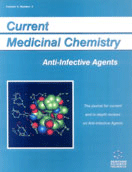Abstract
Bacteria develop resistance to antibiotics by receptor alteration, antibiotic modification and by drug efflux, whereby the antibiotic is removed from intracellular compartments by efflux proteins. This article gives an overview of the chemical and biological properties of the major efflux proteins found within resurgent pathogens, their activity in creating resistance, and the effect of inhibitors of these proteins. The major families of efflux protein inhibitors against bacteria include tetracyclines, indanes, ginsensosides, indoles, reserpine and reserpine analogues, dipeptides, peptidomimetic heterocycles and heterocycles, flavones, and benastatins. Their effect on both Gram-positive and Gram-negative bacteria efflux proteins and bacterial growth is detailed.
Keywords: Antibiotic Efflux, Indanes, Ginsensosides, Reserpine, reserpine analogues, Dipeptides, Flavones, Benastatins, Rhodamine, Tetracycline antibiotics
 20
20

